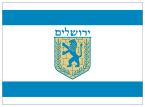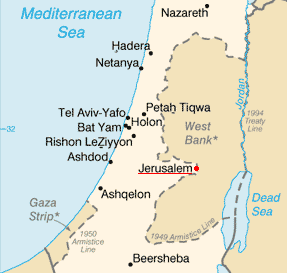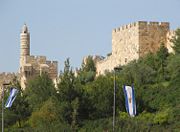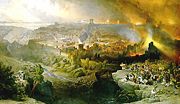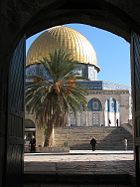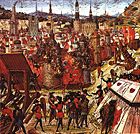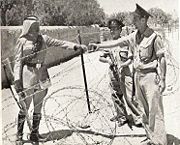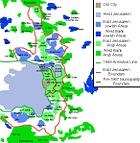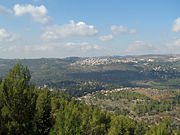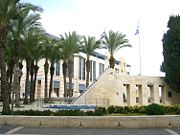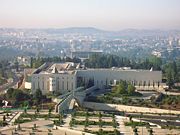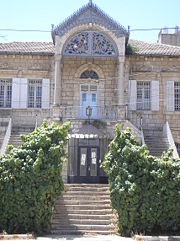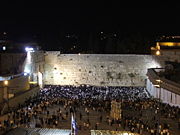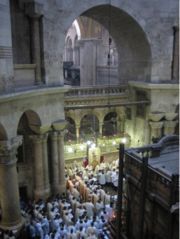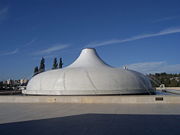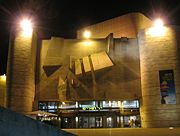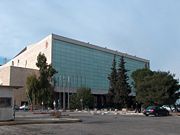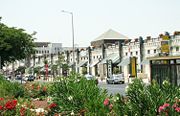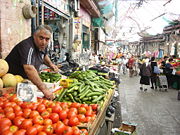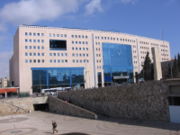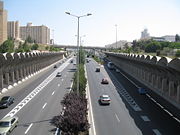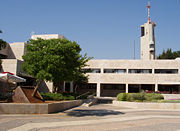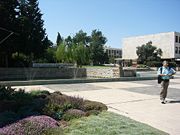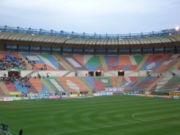Jerusalem
2008/9 Schools Wikipedia Selection. Related subjects: Geography of the Middle East
| Jerusalem | |||
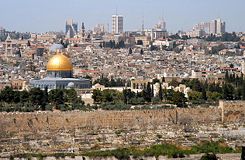 Jerusalem, viewed from the Mount of Olives |
|||
|
|||
| Hebrew | יְרוּשָׁלַיִם (Yerushalayim) | ||
| (Standard) | Yerushalayim | ||
| Arabic | commonly القـُدْس (Al-Quds); officially in Israel أورشليم القدس (Urshalim-Al-Quds) |
||
| Name meaning | Hebrew: (see below), Arabic: "The Holy" |
||
| Government | City | ||
| District | Jerusalem | ||
| Population | 732,100 (2007) | ||
| Jurisdiction | 125,156 dunams (125.156 km²/48.323 sq mi) | ||
| Mayor | Uri Lupolianski | ||
| Website | www.jerusalem.muni.il | ||
Jerusalem (Hebrew: יְרוּשָׁלַיִם (audio) , Yerushaláyim; Arabic: القُدس (audio) , al-Quds) is the capital of Israel and its largest city in both population and area, with 732,100 residents in an area of 125.1 square kilometers (49 sq mi) if disputed East Jerusalem is included. Located in the Judean Mountains, between the Mediterranean Sea and the northern tip of the Dead Sea, modern Jerusalem has grown up outside the Old City.
The city has a history that goes back to the 4th millennium BCE, making it one of the oldest cities in the world. Jerusalem has been the holiest city in Judaism and the spiritual centre of the Jewish people since the 10th century BCE, contains a number of significant ancient Christian sites, and is considered the third-holiest city in Islam. Despite having an area of only 0.9 square kilometer (0.35 square mile), the Old City is home to sites of key religious importance, among them the Temple Mount, the Western Wall, the Church of the Holy Sepulchre, the Dome of the Rock and al-Aqsa Mosque. The old walled city, a World Heritage site, has been traditionally divided into four quarters, although the names used today — the Armenian, Christian, Jewish, and Muslim Quarters — were introduced in the early 19th century. The Old City was nominated for inclusion on the List of World Heritage Sites in danger by Jordan in 1982. In the course of its history, Jerusalem has been destroyed twice, besieged 23 times, attacked 52 times, and captured and recaptured 44 times.
Today, the status of Jerusalem remains one of the core issues in the Israeli-Palestinian conflict. Israel's annexation of occupied East Jerusalem has been repeatedly condemned by the United Nations and related bodies, and Palestinians foresee East Jerusalem as the capital of their future state. In the wake of United Nations Security Council Resolution 478, most foreign embassies moved out of Jerusalem.
Etymology
 Jerusalem |
|---|
|
|
|
Although the origin of the name Yerushalayim is uncertain, various linguistic interpretations have been proposed. Some believe it is a combination of the Hebrew words yerusha (legacy) and shalom (peace), i.e., legacy of peace. Others point out that "shalom" is a cognate of the Hebrew name "Shlomo," i.e., King Solomon, the builder of the First Temple. Alternatively, the second part of the word could be Salem (Shalem literally "whole" or "in harmony"), an early name for Jerusalem that appears in the Book of Genesis. Others cite the Amarna letters, where the Akkadian name of the city appears as Urušalim, a cognate of the Hebrew Ir Shalem. Some believe there is a connection to Shalim, the beneficent deity known from Ugaritic myths as the personification of dusk.
According to a midrash ( Genesis Rabba), Abraham came to the city, then called Shalem, after rescuing Lot. Abraham asked the king and high priest Melchizedek to bless him. This encounter was commemorated by adding the prefix Yeru (derived from Yireh, the name Abraham gave to the Temple Mount) producing Yeru-Shalem, meaning the "city of Shalem," or "founded by Shalem." Shalem means "complete" or "without defect. Hence, "Yerushalayim" means the "perfect city," or "the city of he who is perfect". The ending -im indicates the plural in Hebrew grammar and -ayim the dual, possibly referring to the fact that the city sits on two hills. The pronunciation of the last syllable as -ayim appears to be a late development, which had not yet appeared at the time of the Septuagint.
Some believe that a city called Rušalimum or Urušalimum which appears in ancient Egyptian records is the first reference to Jerusalem.The Greeks added the prefix hiero ("holy") and called it Hierosolyma. To the Arabs, Jerusalem is al-Quds ("The Holy"). It was called Jebus (Yevus) by the Jebusites. "Zion" initially referred to part of the city, but later came to signify the city as a whole. Under King David, it was known as Ir David (the City of David).
History
Ceramic evidence indicates the occupation of Ophel, within present-day Jerusalem, as far back as the Copper Age, c. 4th millennium BCE, with evidence of a permanent settlement during the early Bronze Age, c. 3000-2800 BCE. The Execration Texts ( c. 19th century BCE), which refer to a city called Roshlamem or Rosh-ramen and the Amarna letters (c. 14th century BCE) may be the earliest mention of the city. Some archaeologists, including Kathleen Kenyon, believe Jerusalem as a city was founded by West Semitic people with organized settlements from around 2600 BCE. According to Jewish tradition the city was founded by Shem and Eber, ancestors of Abraham. In the biblical account, Jerusalem was a Jebusite city until the 10th century BCE when David conquered it and made it the capital of the United Kingdom of Israel and Judah (c. 1000s BCE). Recent excavations of a large stone structure are interpreted by some archaeologists as lending credence to the biblical narrative.
Temple periods
King David reigned until 970 BCE. He was succeeded by his son Solomon, who built the Holy Temple on Mount Moriah. Solomon's Temple (later known as the First Temple), went on to play a pivotal role in Jewish history as the repository of the Ark of the Covenant. For over 600 years, until the Babylonian conquest in 587 BCE, Jerusalem was the political and religious capital of the Jews. This period is known in history as the First Temple Period. Upon Solomon's death (c. 930 BCE), the ten northern tribes split off to form the Kingdom of Israel. Under the leadership of the House of David and Solomon, Jerusalem remained the capital of the Kingdom of Judah.
When the Assyrians conquered the Kingdom of Israel in 722 BCE, Jerusalem was strengthened by a great influx of refugees from the northern kingdom. The First Temple period ended around 586 BCE, as the Babylonians conquered Judah and Jerusalem, and laid waste to Solomon's Temple. In 538 BCE, after fifty years of Babylonian captivity, Persian King Cyrus the Great invited the Jews to return to Judah to rebuild Jerusalem and the Temple. Construction of the Second Temple was completed in 516 BCE, during the reign of Darius the Great, seventy years after the destruction of the First Temple. Jerusalem resumed its role as capital of Judah and centre of Jewish worship. When Greek ruler Alexander the Great conquered the Persian Empire, Jerusalem and Judea fell under Greek control, eventually falling to the Ptolemaic dynasty under Ptolemy I. In 198 BCE, Ptolemy V lost Jerusalem and Judea to the Seleucids under Antiochus III. The Seleucid attempt to recast Jerusalem as a Hellenized polis came to a head in 168 BCE with the successful Maccabean revolt of Mattathias the High Priest and his five sons against Antiochus Epiphanes, and their establishment of the Hasmonean Kingdom in 152 BCE with Jerusalem again as its capital.
Jewish-Roman wars
As Rome became stronger it installed Herod as a Jewish client king. Herod the Great, as he was known, devoted himself to developing and beautifying the city. He built walls, towers and palaces, and expanded the Temple Mount, buttressing the courtyard with blocks of stone weighing up to 100 tons. Under Herod, the area of the Temple Mount doubled in size. In 6 CE, the city, as well as much of the surrounding area, came under direct Roman rule as the Iudaea Province and Herod's descendants through Agrippa II remained client kings of Judea until 96 CE. Roman rule over Jerusalem and the region began to be challenged with the first Jewish-Roman war, the Great Jewish Revolt, which resulted in the destruction of the Second Temple in 70 CE. In 130 CE Hadrian Romanized the city, and renamed it Aelia Capitolina. Jerusalem once again served as the capital of Judea during the three-year rebellion known as the Bar Kochba revolt. The Romans succeeded in recapturing the city in 135 CE and as a punitive measure Hadrian banned the Jews from entering it. Hadrian renamed the entire Iudaea Province Syria Palaestina after the biblical Philistines in an attempt to de-Judaize the country. Enforcement of the ban on Jews entering Aelia Capitolina continued until the 4th century CE.
In the five centuries following the Bar Kokhba revolt, the city remained under Roman then Byzantine rule. During the 4th century, the Roman Emperor Constantine I constructed Christian sites in Jerusalem such as the Church of the Holy Sepulchre. Jerusalem reached a peak in size and population at the end of the Second Temple Period: The city covered two square kilometers (0.8 sq mi.) and had a population of 200,000 From the days of Constantine until the 7th century, Jews were banned from Jerusalem.
Roman-Persian wars
Within the span of a few decades, Jerusalem shifted from Roman to Persian rule and returned to Roman dominion once more. Following Sassanid Khosrau II's early seventh century push into Byzantine, advancing through Syria, Sassanid Generals Shahrbaraz and Shahin attacked the Byzantine-controlled city of Jerusalem ( Persian: Dej Houdkh).
In the Siege of Jerusalem (614), after 21 days of relentless siege warfare, Jerusalem was captured and the Persian victory resulted in the territorial annexation of Jerusalem. After the Sassanid army entered Jerusalem, the holy " True Cross" was stolen and sent back to the Sassanian capital as a battle-captured holy relic. The conquered city and the Holy Cross would remain in Sassanid hands for some fifteen years until the Byzantine Emperor Heraclius recovered them in 629.
Islamic rule
In 638, the Islamic Caliphate extended its dominion to Jerusalem. At this time, Jerusalem was declared Islam's third holiest city after Mecca and Medina, and referred to as al Bait al-Muquddas. Later, it was known as al-Quds al-Sharif. With the Arab conquest, Jews were allowed back into the city. The Rashidun caliph Umar ibn al-Khattab signed a treaty with Monophysite Christian Patriarch Sophronius, assuring him that Jerusalem's Christian holy places and population would be protected under Muslim rule. Umar was led to the Foundation Stone on the Temple Mount, which he cleared of refuse in preparation for building a mosque. According to the Gaullic bishop Arculf, who lived in Jerusalem from 679-688, the Mosque of Umar was a rectangular wooden structure built over ruins which could accommodated 3,000 worshipers. The Umayyad caliph Abd al-Malik commissioned the construction of the Dome of the Rock in the late 7th century.The 10th century historian El Muqadasi writes that Abd al-Malik built the shrine in order to compete in grandeur of Jerusalem's monumental churches. Over the next four hundred years, Jerusalem's prominence diminished as Arab powers in the region jockeyed for control.
Crusaders, Saladin and the Mamluks
In 1099, Jerusalem was conquered by the Crusaders, who massacred most of its Muslim inhabitants and the remnants of the Jewish inhabitants. The Christians having been expelled and most of the Jewish inhabitants having already fled, by early June 1099, Jerusalem’s population had declined from 70,000 to less than 30,000. The surviving Jews were sold into slavery in Europe or ransomed to the Jewish community of Egypt. Christian Arab tribes brought to Jerusalem settled in the Old City. In 1187, the city was wrested from the Crusaders by Saladin who permitted Jews and Muslims to return and settle in the city. In 1244, Jerusalem was sacked by the Kharezmian Tartars, who decimated the city's Christian population and drove out the Jews, some of whom resettled in Nablus. From 1250-1517, Jerusalem was ruled by the Mamluks, who imposed a heavy annual tax on the Jews and destroyed Christian holy places on Mount Zion.
Ottoman rule
In 1517, Jerusalem and environs fell to the Ottoman Turks, who remained in control until 1917. With the occupation of Jerusalem by Muhammad Ali of Egypt in 1831, foreign missions and consulates began to establish a foothold in the city. In the 1860s, new neighborhoods began to go up outside the Old City walls to house pilgrims and relieve the intense overcrowding and poor sanitation inside the city. The Russian Compound and Mishkenot Sha'ananim were founded in 1860. According to the Prussian consul, the population in 1845 was 16,410, with 7,120 Jews, 5,000 Muslims, 3,390 Christians, 800 Turkish soldiers and 100 Europeans. The volume of Christian pilgrims increased under the Ottomans, doubling the city's population around Easter time. In 1836, Ibrahim Pasha allowed the Jews to restore four major synagogues, among them the Hurva. Turkish rule was reinstated in 1840, but many Egyptian Muslims remained in Jerusalem. Jews from Algiers and North Africa began to settle in the city in growing numbers. At the same time, the Ottomans built tanneries and slaughterhouses near Christian and Jewish holy places "so that an evil smell should ever plague the infidels." In the 1840s and 1850s, the international powers began a tug-of-war in Palestine as they sought to extend their protection over the country's religious minorities, a struggle carried out mainly through consular representatives in Jerusalem.
British Mandate and 1948 War
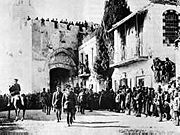
In 1917 after the Battle of Jerusalem, the British Army, led by General Edmund Allenby, captured the city. and in 1922, the League of Nations at Conference of Lausanne entrusted the United Kingdom to administer the Mandate for Palestine.
From 1922 to 1948 the total population of the city rose from 52,000 to 165,000 with two thirds of Jews and one-third of Arabs (Muslims and Christians).. The situation between Arabs and Jews in Palestine was not quiet. At Jerusalem, in particular riots occurred in 1920 and in 1929. Under the British, new garden suburbs were built in the western and northern parts of the city and institutions of higher learning such as the Hebrew University were founded.
As the British Mandate for Palestine was expiring, the 1947 UN Partition Plan recommended "the creation of a special international regime in the City of Jerusalem, constituting it as a corpus separatum under the administration of the United Nations." The international regime was to remain in force for a period of ten years, whereupon a referendum was to be held in which the residents of Jerusalem were to decide the future regime of the city. However, this plan was not implemented, as the 1948 war erupted while the British withdrew from Palestine and Israel declared its independence.
The war led to displacement of Arab and Jewish populations in the city. The 1,500 residents of the Jewish Quarter of the Old City were expelled and a few hundred taken prisoner when the Arab Legion captured the quarter on 28 May. Residents of many Arab villages and neighborhoods west of the Old City left with the approach of the war, but some remained and were driven out or killed, as at Lifta or Deir Yassin.
Division and controversial reunification
The war ended with Jerusalem divided between Israel and Jordan (then Transjordan). The 1949 Armistice Agreements established a ceasefire line that cut through the centre of the city and left Mount Scopus as an Israeli exclave. Barbed wire and concrete barriers separated east and west Jerusalem, and military skirmishes frequently threatened the ceasefire. After the establishment of the State of Israel, Jerusalem was declared its capital. Jordan formally annexed East Jerusalem in 1950, subjecting it to Jordanian law, in a move that was recognized only by Pakistan.
Jordan assumed control of the holy places in the Old City. Contrary to the terms of the agreement, Israelis were denied access to Jewish holy sites, many of which were desecrated, and only allowed very limited access to Christian holy sites. During this period, the Dome of the Rock and al-Aqsa Mosque underwent major renovations.
During the 1967 Six-Day War, Israel captured East Jerusalem and asserted sovereignty over the entire city. Jewish access to holy sites was restored, while the Temple Mount remained under the jurisdiction of an Islamic waqf. The Moroccan Quarter, which was located adjacent to the Western Wall, was vacated and razed to make way for a plaza for those visiting the wall. Since the war, Israel has expanded the city's boundaries and established a ring of Jewish neighbourhoods on vacant land east of the Green Line.
However, the takeover of East Jerusalem was met with international criticism. Following the passing of Israel's Jerusalem Law, which declared Jerusalem, "complete and united", the capital of Israel, the United Nations Security Council passed a resolution that declared the law "a violation of international law" and requested all member states to withdraw all remaining embassies from the city.
The status of the city, and especially its holy places, remains a core issue in the Israeli-Palestinian conflict. Jewish settlers have taken over historic sites and built on land confiscated from Palestinians in order to expand the Jewish presence in East Jerusalem, while prominent Islamic leaders have insisted that Jews have no historical connection to Jerusalem. Palestinians envision East Jerusalem as the capital of a future Palestinian state, and the city's borders have been the subject of bilateral talks.
Geography
Jerusalem is situated on the southern spur of a plateau in the Judean Mountains, which include the Mount of Olives (East) and Mount Scopus (North East). The elevation of the Old City is approximately 760 m (2,500 ft). The whole of Jerusalem is surrounded by valleys and dry riverbeds ( wadis). The Kidron, Hinnom, and Tyropoeon Valleys intersect in an area just south of the Old City of Jerusalem. The Kidron Valley runs to the east of the Old City and separates the Mount of Olives from the city proper. Along the southern side of old Jerusalem is the Valley of Hinnom, a steep ravine associated in biblical eschatology with the concept of Gehenna or Hell.The Tyropoeon valley commenced in the northwest near the Damascus Gate, ran south-southeasterly through the centre of the Old City down to the Pool of Siloam, and divided the lower part into two hills, the Temple Mount to the east, and the rest of the city to the west (the lower and the upper cities described by Josephus). Today, this valley is hidden by debris that has accumulated over the centuries.
In biblical times, Jerusalem was surrounded by forests of almond, olive and pine trees. Over centuries of warfare and neglect, these forests were destroyed. Farmers in the Jerusalem region thus built stone terraces along the slopes to hold back the soil, a feature still very much in evidence in the Jerusalem landscape.
Water supply has always been a major problem in Jerusalem, as attested to by the intricate network of ancient aqueducts, tunnels, pools and cisterns found in the city.
Jerusalem is 60 kilometers (37 mi) east of Tel Aviv and the Mediterranean Sea. On the opposite side of the city, approximately 35 kilometers (22 mi) away, is the Dead Sea, the lowest body of water on Earth. Neighboring cities and towns include Bethlehem and Beit Jala to the south, Abu Dis and Ma'ale Adumim to the east, Mevaseret Zion to the west, and Ramallah and Giv'at Ze'ev to the north.
Climate
The city is characterized by a Mediterranean climate, with hot, dry summers, and cool, rainy winters. Light snow usually falls once or twice a winter, although the city experiences heavy snowfall every seven years on the average. January is the coldest month of the year, with an average temperature of 8 °C (46 °F); July and August are the hottest months, with an average temperature of 23 °C (73 °F). Temperatures vary widely from day to night, and Jerusalem evenings are typically cool even in summer. The average annual precipitation is close to 590 millimetres (23 in) with rain occurring mostly between October and May.
Most of the air pollution in Jerusalem comes from vehicular traffic. Many main streets in Jerusalem were not built to accommodate such a large volume of traffic, leading to traffic congestion and more carbon monoxide released into the air. Industrial pollution inside the city is sparse, but emissions from factories on the Israeli Mediterranean coast can travel eastward and settle over the city.
| Weather averages for Jerusalem | |||||||||||||
|---|---|---|---|---|---|---|---|---|---|---|---|---|---|
| Month | Jan | Feb | Mar | Apr | May | Jun | Jul | Aug | Sep | Oct | Nov | Dec | |
| Average high °C (°F) | 12 (53) | 13 (56) | 16 (61) | 21 (70) | 25 (77) | 28 (82) | 29 (84) | 29 (84) | 28 (82) | 25 (77) | 19 (66) | 14 (57) | |
| Average low °C (°F) | 4 (39) | 4 (40) | 6 (43) | 9 (49) | 12 (54) | 15 (59) | 17 (63) | 17 (63) | 16 (61) | 14 (57) | 9 (49) | 6 (42) | |
| Precipitation mm (inches) | 142.2 (5.6) | 114.3 (4.5) | 99.1 (3.9) | 30.5 (1.2) | 2.5 (0.1) | 0 (0) | 0 (0) | 0 (0) | 0.0 (0.0) | 22.9 (0.9) | 68.8 (2.7) | 109.2 (4.3) | |
| Source: The Weather Channel | |||||||||||||
Demographics
| Year | Total |
|---|---|
| 1844 | 15,510 |
| 1876 | 25,030 |
| 1896 | 45,420 |
| 1922 | 62,578 |
| 1931 | 90,053 |
| 1944 | 157,000 |
| 1948 | 165,000 |
| 1967 | 263,307 |
| 1980 | 407,100 |
| 1985 | 457,700 |
| 1990 | 524,400 |
| 1995 | 617,000 |
| 2000 | 657,500 |
| 2005 | 706,400 |
In May 2007, Jerusalem had a population of 732,100—64% were Jewish, 32% Muslim, and 2% Christian. At the end of 2005, the population density was 5,750.4 inhabitants per square kilometer (14,893.5/sq mi). According to a study published in 2000, the percentage of Jews in the city's population had been decreasing; this was attributed to a higher Palestinian birth rate, and Jewish residents leaving. The study also found that about nine percent of the Old City's 32,488 people were Jews.
In 2005, 2,850 new immigrants settled in Jerusalem, mostly from the United States, France and the former Soviet Union. In terms of the local population, the number of outgoing residents exceeds the number of incoming residents. In 2005, 16,000 left Jerusalem and only 10,000 moved in. Nevertheless, the population of Jerusalem continues to rise due to the high birth rate, especially in the Arab and Haredi Jewish communities. Consequently, the total fertility rate in Jerusalem (4.02) is higher than in Tel Aviv (1.98) and well above the national average of 2.90. The average size of Jerusalem's 180,000 households is 3.8 people.
In 2005, the total population grew by 13,000 (1.8%) — similar to Israeli national average, but the religious and ethnic composition is shifting. While 31% of the Jewish population is made up of children below the age fifteen, the figure for the Arab population is 42%. This would seem to corroborate the observation that the percentage of Jews in Jerusalem has declined over the past four decades. In 1967, Jews accounted for 74 percent of the population, while the figure for 2006 is down nine percent. Possible factors are the high cost of housing, fewer job opportunities and the increasingly religious character of the city. Many people are moving to the suburbs and coastal cities in search of cheaper housing and a more secular lifestyle.
Demographics and the Jewish-Arab population divide play a major role in the dispute over Jerusalem. In 1998, the Jerusalem Development Authority proposed expanding city limits to the west to include more areas heavily populated with Jews.
Criticism of urban planning
Critics of efforts to promote a Jewish majority in Israel say that government planning policies are motivated by demographic considerations and seek to limit Arab construction while promoting Jewish construction. According to a World Bank report, the number of recorded building violations between 1996 and 2000 was four and half times higher in Jewish neighborhoods but four times fewer demolition orders were issued in West Jerusalem than in East Jerusalem; Palestinians in Jerusalem were less likely to receive construction permits than Jews, and "the authorities are much more likely to take action against Palestinian violators" than Jewish violators of the permit process. In recent years, private Jewish foundations have received permission from the government to develop projects on disputed lands, such as the City of David archaeological park in the Palestinian neighbourhood of Silwan (adjacent to the Old City), and the Museum of Tolerance on Mamilla cemetery (adjacent to Zion Square). The Israeli government has also expropriated Palestinian land for the construction of the Israeli West Bank barrier. Opponents view such urban planning moves as geared towards the Judaization of Jerusalem.
Local government
The Jerusalem City Council is a body of 31 elected members headed by the mayor, who serves a five-year term and appoints six deputies. The current mayor of Jerusalem, Uri Lupolianski, was elected in 2003. Apart from the mayor and his deputies, City Council members receive no salaries and work on a voluntary basis. The longest-serving Jerusalem mayor was Teddy Kollek, who spent twenty-eight years — six consecutive terms — in office. Most of the meetings of the Jerusalem City Council are private, but each month, it holds a session that is open to the public. Within the city council, religious political parties form an especially powerful faction, accounting for the majority of its seats. The headquarters of the Jerusalem Municipality and the mayor's office are at Safra Square (Kikar Safra) on Jaffa Road. The new municipal complex, comprising two modern buildings and ten renovated historic buildings surrounding a large plaza, opened in 1993. The city falls under the Jerusalem District, with Jerusalem as the district's capital.
Political status
On December 5, 1949, the State of Israel's first Prime Minister, David Ben-Gurion, proclaimed Jerusalem as Israel's capital and since then all branches of the Israeli government — legislative, judicial, and executive — have resided there. At the time of the proclamation, Jerusalem was divided between Israel and Jordan and thus only West Jerusalem was considered Israel's capital. Immediately after the 1967 Six-Day War, however, Israel annexed East Jerusalem, making it a de facto part of the Israeli capital. Israel enshrined the status of the "complete and united" Jerusalem — west and east — as its capital, in the 1980 Basic Law: Jerusalem, Capital of Israel.
The status of a "united Jerusalem" as Israel's "eternal capital" has been a matter of immense controversy within the international community. Although some countries maintain consulates in Jerusalem, and two maintain embassies in Jerusalem suburbs, all embassies are located outside of the city proper, mostly in Tel Aviv.
The non-binding United Nations Security Council Resolution 478, passed on August 20, 1980, declared that the Basic Law was "null and void and must be rescinded forthwith." Member states were advised to withdraw their diplomatic representation from the city as a punitive measure. Most of the remaining countries with embassies in Jerusalem complied with the resolution by relocating them to Tel Aviv, where many embassies already resided prior to Resolution 478. Currently there are no embassies located within the city limits of Jerusalem, although there are embassies in Mevaseret Zion, on the outskirts of Jerusalem, and four consulates in the city itself. In 1995, the United States Congress had planned to move its embassy from Tel Aviv to Jerusalem with the passage of the Jerusalem Embassy Act. However, U.S. President George W. Bush has argued that Congressional resolutions regarding the status of Jerusalem are merely advisory. The Constitution reserves foreign relations as an executive power, and as such, the US embassy is still in Tel Aviv.
Israel's most prominent governmental institutions, including the Knesset, the Supreme Court, and the official residences of the President and Prime Minister, are located in Jerusalem. Prior to the creation of the State of Israel, Jerusalem served as the administrative capital of the British Mandate, which included present-day Israel and Jordan. From 1949 until 1967, West Jerusalem served as Israel's capital but was not recognized as such internationally because UN General Assembly Resolution 194 envisaged Jerusalem as an international city. As a result of the Six-Day War in 1967, the whole of Jerusalem came under Israeli control. On June 27, 1967, the government of Levi Eshkol extended Israeli law and jurisdiction to East Jerusalem, but agreed that administration of the Temple Mount compound would be maintained by the Jordanian waqf, under the Jordanian Ministry of Religious Endowments. In 1988, Israel ordered the closure of Orient House, home of the Arab Studies Society, but also the headquarters of the Palestine Liberation Organization, for security reasons. The building reopened in 1992 as a Palestinian guesthouse. The Oslo Accords stated that the final status of Jerusalem would be determined by negotiations with the Palestinian National Authority, which regards East Jerusalem as the capital of a future Palestinian state.
Religious significance
Jerusalem plays an important role in Judaism, Christianity, and Islam. The 2000 Statistical Yearbook of Jerusalem lists 1204 synagogues, 158 churches, and 73 mosques within the city. Despite efforts to maintain peaceful religious coexistence, some sites, such as the Temple Mount, have been a continuous source of friction and controversy.
Jerusalem has been sacred to the Jews since King David proclaimed it his capital in the 10th century BCE. Jerusalem was the site of Solomon's Temple and the Second Temple. Synagogues around the world are traditionally built with the Holy Ark facing Jerusalem, and Arks within Jerusalem face the "Holy of Holies". As prescribed in the Mishna and codified in the Shulchan Aruch, daily prayers are recited while facing towards Jerusalem and the Temple Mount. Many Jews have " Mizrach" plaques hung on a wall of their homes to indicate the direction of prayer.
Christianity reveres Jerusalem not only for its Old Testament history but for its significance in the life of Jesus. According to the New Testament, Jesus was brought to Jerusalem soon after his birth and later in his life cleansed the Second Temple. The Cenacle, believed to be the site of Jesus' Last Supper, is located on Mount Zion in the same building that houses the Tomb of King David. Another prominent Christian site in Jerusalem is Golgotha, the site of the crucifixion. The Gospel of John describes it as being located outside Jerusalem, but recent archaeological evidence suggests Golgotha is a short distance from the Old City walls, within the present-day confines of the city. The land currently occupied by the Church of the Holy Sepulchre is considered one of the top candidates for Golgotha and thus has been a Christian pilgrimage site for the past two thousand years.
Jerusalem is considered the third-holiest city in Islam. For approximately a year, before it was permanently switched to the Kabaa in Mecca, the qibla (direction of prayer) for Muslims was Jerusalem. The city's lasting place in Islam, however, is primarily due to Muhammad's Night of Ascension (c. 620 CE). Muslims believe Muhammad was miraculously transported one night from Mecca to the Temple Mount in Jerusalem, whereupon he ascended to Heaven to meet previous prophets of Islam. The first verse in the Qur'an's Surat al-Isra notes the destination of Muhammad's journey as al-Aqsa (the farthest) mosque, in reference to the location in Jerusalem. Today, the Temple Mount is topped by two Islamic landmarks intended to commemorate the event — al-Aqsa Mosque, derived from the name mentioned in the Qur'an, and the Dome of the Rock, which stands over the Foundation Stone, from which Muslims believe Muhammad ascended to Heaven.
Culture
Although Jerusalem is known primarily for its religious significance, the city is also home to many artistic and cultural venues. The Israel Museum attracts nearly one million visitors a year, approximately one-third of them tourists. The 20 acre museum complex comprises several buildings featuring special exhibits and extensive collections of Judaica, archaeological findings, and Israeli and European art. The Dead Sea scrolls, discovered in the mid-twentieth century in the Qumran caves near the Dead Sea, are housed in the Museum's Shrine of the Book. The Youth Wing, which mounts changing exhibits and runs an extensive art education program, is visited by 100,000 children a year. The museum has a large outdoor sculpture garden, and a scale-model of the Second Temple was recently moved from the Holyland Hotel to a new location on the museum grounds. The Rockefeller Museum, located in East Jerusalem, was the first archaeological museum in the Middle East. It was built in 1938 during the British Mandate. The Islamic Museum on the Temple Mount, established in 1923, houses many Islamic artifacts, from tiny kohl flasks and rare manuscripts to giant marble columns.
Yad Vashem, Israel's national memorial to the victims of the Holocaust, houses the world's largest library of Holocaust-related information, with an estimated 100,000 books and articles. The complex contains a state-of-the-art museum that explores the genocide of the Jews through exhibits that focus on the personal stories of individuals and families killed in the Holocaust and an art gallery featuring the work of artists who perished. Yad Vashem also commemorates the 1.5 million Jewish children murdered by the Nazis, and honours the Righteous among the Nations. The Museum on the Seam, which explores issues of coexistence through art is situated on the road dividing eastern and western Jerusalem.
The Jerusalem Symphony Orchestra, established in the 1940s, has appeared around the world. Other arts facilities include the International Convention Centre (Binyanei HaUma) near the entrance to city, where the Israel Philharmonic Orchestra plays, the Jerusalem Cinemateque, the Gerard Behar Centre (formerly Beit Ha'am) in downtown Jerusalem, the Jerusalem Music Centre in Yemin Moshe, and the Targ Music Centre in Ein Kerem. The Israel Festival, featuring indoor and outdoor performances by local and international singers, concerts, plays and street theatre, has been held annually since 1961; for the past 25 years, Jerusalem has been the major organizer of this event. The Jerusalem Theatre in the Talbiya neighborhood hosts over 150 concerts a year, as well as theatre and dance companies and performing artists from overseas. The Khan, located in a caravansarai opposite the old Jerusalem train station, is the city's only repertoire theatre. The station itself has become a venue for cultural events in recent years, as the site of Shav'ua Hasefer, an annual week-long book fair, and outdoor music performances. The Jerusalem Film Festival is held annually, screening Israeli and international films.
The Palestinian National Theatre, for many years the only Arab cultural centre in East Jerusalem, seeks new ideas and innovative approaches to Palestinian self-expression. The Ticho House, in downtown Jerusalem, houses the paintings of Anna Ticho and the Judaica collections of her husband, an ophthalmologist who opened Jerusalem's first eye clinic in this building in 1912. Al-Hoash, established in 2004, is a gallery for the preservation of Palestinian art.
Economy
Historically, Jerusalem's economy was supported almost exclusively by religious pilgrims, as it was located far from the major ports of Jaffa and Gaza. Jerusalem's religious landmarks today remain the top draw for foreign visitors, with the majority of tourists visiting the Western Wall and the Old City, but in the past half-century it has become increasingly clear that Jerusalem's providence cannot solely be sustained by its religious significance.
Although many statistics indicate economic growth in the city, since 1967 East Jerusalem has lagged behind the development of West Jerusalem. Nevertheless, the percentage of households with employed persons is higher for Arab households (76.1%) than for Jewish households (66.8%). The unemployment rate in Jerusalem (8.3%) is slightly better than the national average (9.0%), although the civilian labor force accounted for less than half of all persons fifteen years or older — lower in comparison to that of Tel Aviv (58.0%) and Haifa (52.4%). Poverty in the city has increased dramatically in recent years; between 2001 and 2007, the number of people below the poverty threshold increased by forty percent. In 2006, the average monthly income for a worker in Jerusalem was NIS5,940 (US$1,410), NIS1,350 less than that for a worker in Tel Aviv.
During the British Mandate, a law was passed requiring all buildings to be constructed of Jerusalem stone in order to preserve the unique historic and aesthetic character of the city. Complementing this building code, which is still in force, is the discouragement of heavy industry in Jerusalem; only about 2.2% of Jerusalem's land is zoned for "industry and infrastructure." By comparison, the percentage of land in Tel Aviv zoned for industry and infrastructure is twice as high, and in Haifa, seven times as high. Only 8.5% of the Jerusalem District work force is employed in the manufacturing sector, which is half the national average (15.8%). Higher than average percentages are employed in education (17.9% vs. 12.7%); health and welfare (12.6% vs. 10.7%); community and social services (6.4% vs. 4.7%); hotels and restaurants (6.1% vs. 4.7%); and public administration (8.2% vs. 4.7%). Although Tel Aviv remains Israel's financial centre, a growing number of high tech companies are moving to Jerusalem, providing 12,000 jobs in 2006. Northern Jerusalem's Har Hotzvim industrial park is home to some of Israel's major corporations, among them Intel, Teva Pharmaceutical Industries, and ECI Telecom. Expansion plans for the park envision one hundred businesses, a fire station, and a school, covering an area of 530,000 m² (130 acres).
Since the establishment of the State of Israel, the national government has remained a major player in Jerusalem's economy. The government, centered in Jerusalem, generates a large number of jobs, and offers subsidies and incentives for new business initiatives and start-ups.
Transportation
The airport nearest to Jerusalem is Atarot Airport, which was used for domestic flights until its closure in 2001. Since then it has been under the control of the Israel Defense Forces due to disturbances in Ramallah and the West Bank. All air traffic from Atarot was rerouted to Ben Gurion International Airport, Israel's largest and busiest airport, which serves nine million passengers annually.
Egged Bus Cooperative, the second-largest bus company in the world, handles most of the local and intercity bus service out of the city's Central Bus Station on Jaffa Road near the western entrance to Jerusalem from highway 1. As of 2008, Egged buses, taxicabs and private cars are the only transportation options in Jerusalem. However, this will change with the completion of the Jerusalem Light Rail, a new rail-based transit system currently under construction. The rail system will be capable of transporting an estimated 200,000 people daily. It will have 24 stops, and is scheduled for completion in January 2009.
Another work in progress is a new high-speed rail line from Tel Aviv to Jerusalem, which is scheduled to be completed in 2011. Its terminus will be an underground station (80m deep) serving the national Convention centre and the Central Bus Station, and is planned to be extended eventually to Malha station. Israel Railways operates train services to Malha train station from Tel Aviv via Beit Shemesh.
Begin Expressway is one of Jerusalem's major north-south thoroughfares; it runs on the western side of the city, merging in the north with Route 443, which continues toward Tel Aviv. Route 60 runs through the centre of the city near the Green Line between East and West Jerusalem. Construction is progressing on parts of a 35-kilometer (22-mile) ring road around the city, fostering faster connection between the suburbs. The eastern half of the project was conceptualized decades ago, but reaction to the proposed highway is still mixed.
Education
Jerusalem is home to several prestigious universities, with courses offered in Hebrew, Arabic, and English. Founded in 1925, the Hebrew University of Jerusalem is one of the most respected institutions of higher learning in Israel. The Board of Governors has included such prominent Jewish intellectuals as Albert Einstein and Sigmund Freud. The university has produced several Nobel laureates; recent winners associated with Hebrew University include Avram Hershko, David Gross, and Daniel Kahneman. One of the university's major assets is the Jewish National and University Library, which houses over five million books. The library opened in 1892, over three decades before the university was established, and is one of the world's largest repositories of books on Jewish subjects. Today it is both the central library of the university and the national library of Israel. The Hebrew University operates three campuses in Jerusalem, on Mount Scopus, on Giv'at Ram and a medical campus at the Hadassah Ein Kerem hospital.
Al-Quds University was established in 1984 to serve as a flagship university for the Arab and Palestinian peoples. It describes itself as the "only Arab university in Jerusalem". Al-Quds University resides southeast of the city proper on a campus encompassing 190,000 square metres (47 acres). Other institutions of higher learning in Jerusalem are the Jerusalem Academy of Music and Dance and Bezalel Academy of Art and Design, whose buildings are located on the campuses of the Hebrew University.
The Jerusalem College of Technology, founded in 1969, combines training in engineering and other high-tech industries with a Jewish studies program. It is one of many schools in Jerusalem, from elementary school and up, that combine secular and religious studies. Numerous religious educational institutions and Yeshivot are based in the city, with the Mir yeshiva claiming to be the largest. There were nearly 8,000 twelfth-grade students in Hebrew-language schools during the 2003–2004 school year. However, due to the large portion of students in Haredi Jewish frameworks, only fifty-five percent of twelfth graders took matriculation exams ( Bagrut) and only thirty-seven percent were eligible to graduate. Unlike public schools, many Haredi schools do not prepare students to take standardized tests. To attract more university students to Jerusalem, the city has begun to offer a special package of financial incentives and housing subsidies to students who rent apartments in downtown Jerusalem.
Schools for Arabs in Jerusalem and other parts of Israel have been criticized for offering a lower quality education than those catering to Israeli Jewish students. While many schools in the heavily Arab East Jerusalem are filled to capacity and there have been complaints of overcrowding, the Jerusalem Municipality is currently building over a dozen new schools in the city's Arab neighborhoods. Three schools, in the neighborhoods of Ras el-Amud and Umm Lison, will open in 2008. In March 2007, the Israeli government approved a 5-year plan to build 8,000 new classrooms in the city, 40 percent in the Arab sector and 28 percent in the Haredi sector. A budget of 4.6 billion shekels was allocated for this project. In 2008, Jewish British philanthropists donated $3 million for the construction of schools in Arab East Jerusalem. Arab high school students take the Bagrut matriculation exams, so that much of their curriculum parallels that of other Israeli high schools and includes certain Jewish subjects.
Sports
The two most popular sports in Jerusalem, and Israel as a whole, are football (soccer) and basketball. Beitar Jerusalem Football Club is one of the most popular teams in Israel. Fans include several former and current political figures who make a point of attending its games. Jerusalem's other major football team, and one of Beitar's top rivals, is Hapoel Katamon F.C. Whereas Beitar has been Israel State Cup champion five times, Hapoel has only won the Cup once. Also, Beitar plays in the more prestigious Ligat HaAl, while Hapoel is in the third division national league.
In basketball, Hapoel Jerusalem is higher up on the scale, playing in the top division; though it has yet to win a championship, the club has won the State Cup three times, and the ULEB Cup in 2004. Since its opening in 1992, Teddy Kollek Stadium has been Jerusalem's primary football stadium, with a capacity of 21,000.

